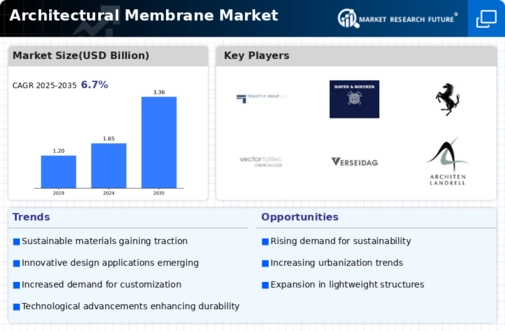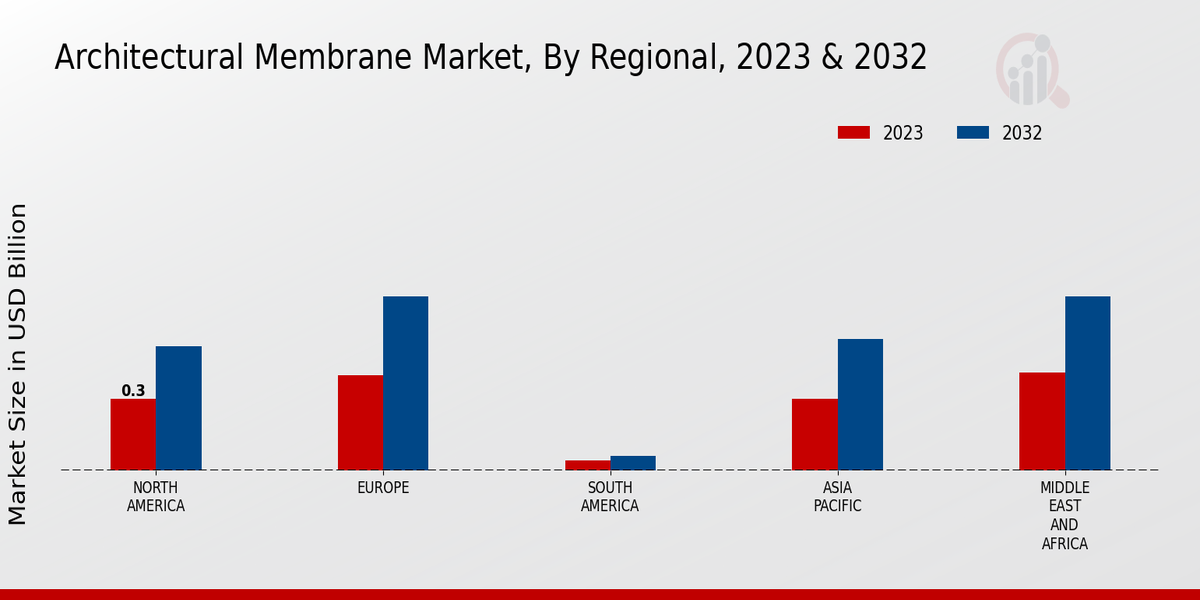Innovative Design Trends
Innovative design trends are significantly influencing the Global Architectural Membrane Market Industry. Architects are increasingly exploring the aesthetic potential of membranes, utilizing them to create striking and functional structures. Membranes allow for unique shapes and forms that traditional materials cannot achieve, thus enhancing the visual appeal of buildings. Notable examples include the Allianz Arena in Munich and the Eden Project in the UK, which showcase the versatility of membrane structures. This trend is expected to contribute to the market's growth, with projections indicating a value of 3.36 USD Billion by 2035, as more projects incorporate these innovative designs.
Market Growth Projections
The Global Architectural Membrane Market Industry is poised for substantial growth, with projections indicating a market value of 1.65 USD Billion in 2024 and an anticipated increase to 3.36 USD Billion by 2035. This growth trajectory suggests a compound annual growth rate of 6.68% from 2025 to 2035, reflecting the increasing adoption of architectural membranes across various sectors. The expanding applications of these materials in commercial, residential, and industrial projects indicate a robust demand that is likely to persist. This upward trend in market growth underscores the evolving landscape of architectural design and construction.
Technological Advancements
Technological advancements play a crucial role in shaping the Global Architectural Membrane Market Industry. Innovations in material science have led to the development of high-performance membranes that offer enhanced durability, weather resistance, and aesthetic qualities. For example, advancements in coating technologies have improved the longevity and maintenance of architectural membranes, making them more appealing to architects and builders. As these technologies evolve, they are likely to drive market growth, enabling the creation of more complex and sustainable structures. The integration of smart technologies into membrane applications may further enhance their functionality and appeal.
Regulatory Support and Incentives
Regulatory support and incentives are increasingly influencing the Global Architectural Membrane Market Industry. Governments worldwide are implementing policies that promote the use of sustainable building materials, including architectural membranes. These regulations often provide financial incentives for projects that utilize eco-friendly materials, thereby encouraging architects and developers to adopt membranes in their designs. This supportive regulatory environment is expected to bolster market growth, as more stakeholders recognize the benefits of compliance with sustainability standards. As a result, the market is likely to experience a positive trajectory in the coming years.
Sustainable Construction Practices
The Global Architectural Membrane Market Industry is increasingly driven by the adoption of sustainable construction practices. Architects and builders are prioritizing materials that minimize environmental impact, leading to a rise in the use of architectural membranes. These materials are often lightweight, durable, and recyclable, aligning with global sustainability goals. For instance, membranes made from PVC and ETFE are gaining traction due to their energy efficiency and low carbon footprint. As the industry shifts towards greener solutions, the market is projected to reach 1.65 USD Billion in 2024, reflecting a growing commitment to eco-friendly building practices.
Urbanization and Infrastructure Development
Urbanization and infrastructure development are pivotal drivers of the Global Architectural Membrane Market Industry. As cities expand, there is a heightened demand for versatile building materials that can accommodate rapid construction needs. Architectural membranes offer a practical solution, providing lightweight and flexible options for various applications, from stadiums to commercial buildings. The ongoing global urbanization trend suggests that the market will continue to thrive, with a compound annual growth rate of 6.68% anticipated from 2025 to 2035. This growth reflects the increasing reliance on membranes to meet the demands of modern urban environments.









